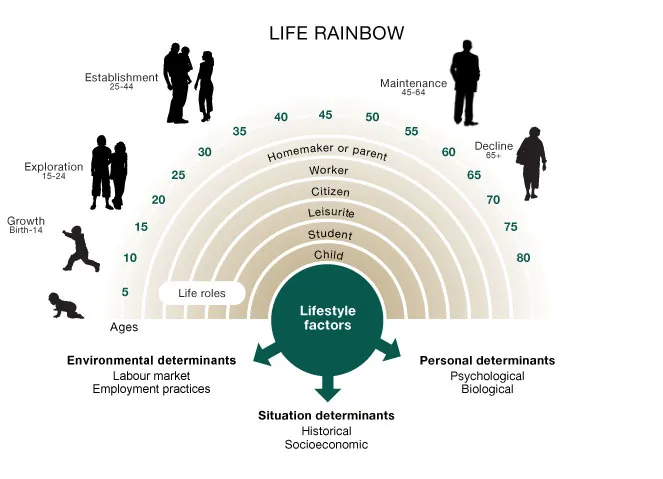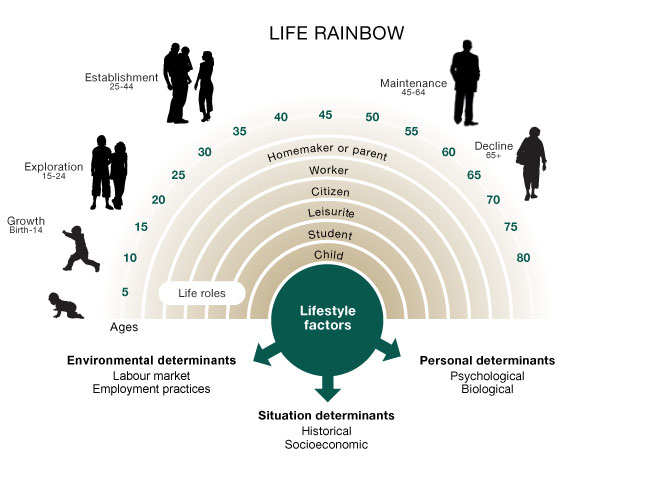
Donald Super created a developmental model which emphasized how personal experiences interact with occupational preferences in creating one’s self-concept. Many theorists before him simply looked at personality and occupation and focused on a trait matching approach.
One of Super’s greatest contributions to career development was his emphasis on the importance of developing a self-concept, as well as his recognition that this self-concept can change with new experiences over time. Before this, career development was mostly seen as a singular choice; however, Super viewed career development as a lifelong activity.
This might not seem groundbreaking today, but it was a marked change from the way theorists thought when Super began formulating his theoretical concepts in the 1950's. In addition to recognizing that people change over their lifetime, he also identified different areas or “life-spaces” that help make a person who they are. The six main life-spaces that make up who we are include: parent/homemaker, worker, citizen, leisurite, student, and child. So many of these roles imply that other people are involved in our lives and thus impact who we are. There are many other spaces in one’s life - other than work - and Super believed that these inhabited social spaces didn’t constitute a distraction but were an integral part of the rainbow of our lives. (Figure from http://career.iresearchnet.com/career-development/supers-career-development-theory/.)
 Super’s self-concept is the belief that our identities and by extension our career identities are a product of how we see ourselves. Our vocational choices put this concept into practice in the real world.
Super’s Five Life and Career Development Stages
1. Growth (Age: birth – 14)
Characteristics: development of self-concept attitudes, and general world of work
2. Exploration (Age 15 – 24)
Trying out classes, work, hobbies; tentative choice and skill development
3. Establishment (Age 25 – 44)
Entry-level skill building and stabilizing work experience
4. Maintenance (Age 45 –64)
Continual adjustment process to improve position
5. Decline (Age 65+)
Reduced output, preparation for retirement
The stages that Super outlined are guides looking at a macro-perspective of one’s life. These stages often correlate with important events and denote a time of transition. Look at the stages and see where you fit in. Do you agree with how they are laid out? Some critics have argued or adjusted these stages and say that the language used is too deeply rooted in a 1950's perspective.
Either way, if you are looking for a key takeaway in reviewing this theory and trying to find a practical application to your life, then simply remember this. Super’s work was important because his idea of the self-concept profoundly changed the field of career development. It challenged individuals to construct their own identification and understanding of their life-space identities including that of their careers. Take a moment to think about and list all of the roles (scientist, parent, yogi, dog owner, caregiver, student etc.) you assume in your life. These roles will likely change depending on your life stage. Super’s theory is a good reminder that an individual’s life situation changes with time and experience while noting that the concept of vocational maturity may or may not correspond with biological age. People may find themselves in the Exploration stage at 35 years-old since people tend to cycle through these stages when they go through career transitions.
Super’s self-concept is the belief that our identities and by extension our career identities are a product of how we see ourselves. Our vocational choices put this concept into practice in the real world.
Super’s Five Life and Career Development Stages
1. Growth (Age: birth – 14)
Characteristics: development of self-concept attitudes, and general world of work
2. Exploration (Age 15 – 24)
Trying out classes, work, hobbies; tentative choice and skill development
3. Establishment (Age 25 – 44)
Entry-level skill building and stabilizing work experience
4. Maintenance (Age 45 –64)
Continual adjustment process to improve position
5. Decline (Age 65+)
Reduced output, preparation for retirement
The stages that Super outlined are guides looking at a macro-perspective of one’s life. These stages often correlate with important events and denote a time of transition. Look at the stages and see where you fit in. Do you agree with how they are laid out? Some critics have argued or adjusted these stages and say that the language used is too deeply rooted in a 1950's perspective.
Either way, if you are looking for a key takeaway in reviewing this theory and trying to find a practical application to your life, then simply remember this. Super’s work was important because his idea of the self-concept profoundly changed the field of career development. It challenged individuals to construct their own identification and understanding of their life-space identities including that of their careers. Take a moment to think about and list all of the roles (scientist, parent, yogi, dog owner, caregiver, student etc.) you assume in your life. These roles will likely change depending on your life stage. Super’s theory is a good reminder that an individual’s life situation changes with time and experience while noting that the concept of vocational maturity may or may not correspond with biological age. People may find themselves in the Exploration stage at 35 years-old since people tend to cycle through these stages when they go through career transitions.
 Super’s self-concept is the belief that our identities and by extension our career identities are a product of how we see ourselves. Our vocational choices put this concept into practice in the real world.
Super’s Five Life and Career Development Stages
1. Growth (Age: birth – 14)
Characteristics: development of self-concept attitudes, and general world of work
2. Exploration (Age 15 – 24)
Trying out classes, work, hobbies; tentative choice and skill development
3. Establishment (Age 25 – 44)
Entry-level skill building and stabilizing work experience
4. Maintenance (Age 45 –64)
Continual adjustment process to improve position
5. Decline (Age 65+)
Reduced output, preparation for retirement
The stages that Super outlined are guides looking at a macro-perspective of one’s life. These stages often correlate with important events and denote a time of transition. Look at the stages and see where you fit in. Do you agree with how they are laid out? Some critics have argued or adjusted these stages and say that the language used is too deeply rooted in a 1950's perspective.
Either way, if you are looking for a key takeaway in reviewing this theory and trying to find a practical application to your life, then simply remember this. Super’s work was important because his idea of the self-concept profoundly changed the field of career development. It challenged individuals to construct their own identification and understanding of their life-space identities including that of their careers. Take a moment to think about and list all of the roles (scientist, parent, yogi, dog owner, caregiver, student etc.) you assume in your life. These roles will likely change depending on your life stage. Super’s theory is a good reminder that an individual’s life situation changes with time and experience while noting that the concept of vocational maturity may or may not correspond with biological age. People may find themselves in the Exploration stage at 35 years-old since people tend to cycle through these stages when they go through career transitions.
Super’s self-concept is the belief that our identities and by extension our career identities are a product of how we see ourselves. Our vocational choices put this concept into practice in the real world.
Super’s Five Life and Career Development Stages
1. Growth (Age: birth – 14)
Characteristics: development of self-concept attitudes, and general world of work
2. Exploration (Age 15 – 24)
Trying out classes, work, hobbies; tentative choice and skill development
3. Establishment (Age 25 – 44)
Entry-level skill building and stabilizing work experience
4. Maintenance (Age 45 –64)
Continual adjustment process to improve position
5. Decline (Age 65+)
Reduced output, preparation for retirement
The stages that Super outlined are guides looking at a macro-perspective of one’s life. These stages often correlate with important events and denote a time of transition. Look at the stages and see where you fit in. Do you agree with how they are laid out? Some critics have argued or adjusted these stages and say that the language used is too deeply rooted in a 1950's perspective.
Either way, if you are looking for a key takeaway in reviewing this theory and trying to find a practical application to your life, then simply remember this. Super’s work was important because his idea of the self-concept profoundly changed the field of career development. It challenged individuals to construct their own identification and understanding of their life-space identities including that of their careers. Take a moment to think about and list all of the roles (scientist, parent, yogi, dog owner, caregiver, student etc.) you assume in your life. These roles will likely change depending on your life stage. Super’s theory is a good reminder that an individual’s life situation changes with time and experience while noting that the concept of vocational maturity may or may not correspond with biological age. People may find themselves in the Exploration stage at 35 years-old since people tend to cycle through these stages when they go through career transitions.Categories
Career Exploration & Planning




